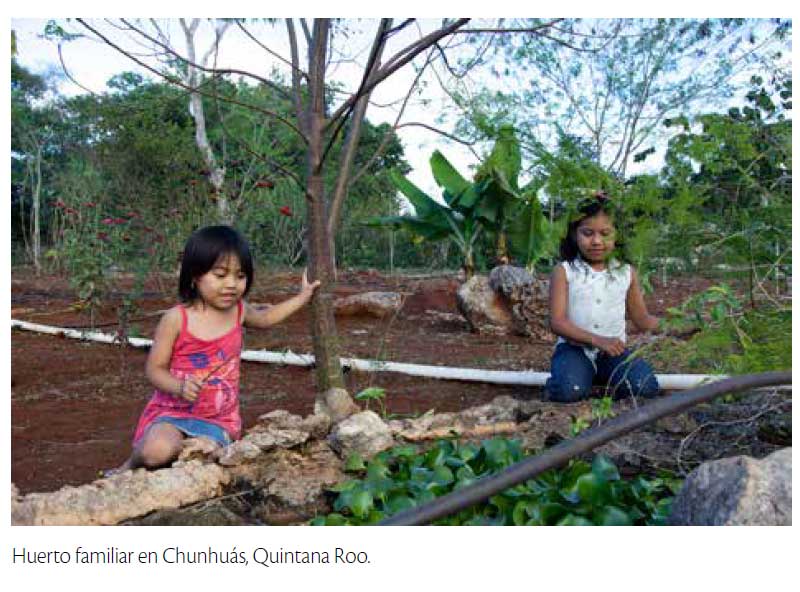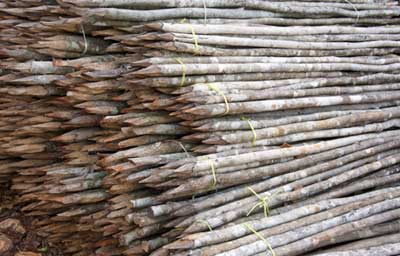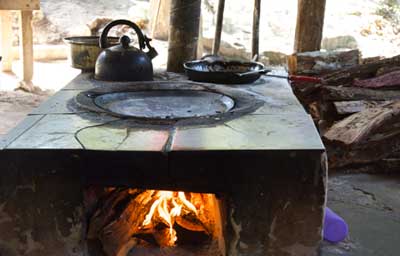Estrategia agroecológica y seguridad alimentaria
 Introducción La Estrategia Agroecológica de U’yo’olché se inicia bajo un concepto de escuela campesina que promueve la seguridad alimentaria en las comunidades a través de la producción orgánica, el intercambio de experiencias y el rescate de conocimiento tradicional campesino. Es un colectivo de productores de hortalizas orgánicas a los cuales se les brinda capacitación constante, seguimiento, y en algunos casos en que se logra acceder a fondos se les provee de infraestructura para el sistema de riego que funcionan con paneles solares. La vida alrededor de la huerta incorpora un ambiente familiar en el trabajo de campo, la cooperación entre las familias de la comunidad que participan en la escuela campesina, y el sentimiento de colaboración entre comunidades vecinas. El objetivo inicial de proveer alimentos para el autoconsumo y lograr sostenibilidad ya está siendo alcanzado, y en este momento han logrado producir excedentes con los cuales esperan dar un paso hacia la comercialización. “La idea del proyecto nació como una comisión interinstitucional que fue liderada por PNUD, CDI, Dirección de Desarrollo Económico de Felipe Carrillo Puerto, CBM, UIMQROO y personas con experiencia para la fundación de una escuela campesina”, explica María Antonieta Bocanegra, co-coordinadora de la línea estrategia de agricultura sustentable de U’yo’olché. “Formamos un equipo con el objetivo de gestionar fondos y capacitarnos en este tema, por eso tomamos un curso para formadores de escuelas campesinas que se desarrolló en la escuela de agricultura U Yits Ka’an, en Maní, Yucatán. La idea original que teníamos era de crear una escuela para campesinos en Felipe Carrillo Puerto, pero con la experiencia de 20 años que nos transmitieron en Maní nos dimos cuenta que sería mejor no sacar a los campesinos de su contexto para trabajar en el campo”. Eso implicó que los esfuerzos de procuración de fondos para la infraestructura de la escuela se podían dirigir mejor hacia que la escuela fuera el propio campo en las comunidades, al aire libre y de campesino a campesino. Al iniciar el proyecto mucha gente se creó expectativas económicas que luego no se cumplían como esperaban, por eso hubo mucha deserción y el grupo se fue reduciendo. De esa manera fueron quedando pocas personas pero con mucho compromiso, que dedican tiempo al trabajo y están convencidos con la producción orgánica, según explica María Antonieta. “Siempre queremos que se involucre más gente, pero no es tarea fácil porque no pagamos por el trabajo, el beneficio es el autoconsumo, y si hay excedentes se vende en el mercado local. Si aprendemos a organizarnos y ahorrar podemos ampliar el huerto y reinvertir, es un proceso lento”, cuenta María Antonieta. Con el segundo financiamiento que se obtuvo para la estrategia agroecológica se compraron semillas, herramientas y sistemas de riego que funcionan con energía solar, además se organizaron cursos de capacitación para la producción orgánica de hortalizas. Las cinco comunidades involucradas en la propuesta comparten equipos y trabajan de manera colectiva.
Un momento clave para el proyecto fue la incorporación de personal en el equipo técnico, ya que era muy necesaria la interdisciplinariedad y mucho compromiso para seguir acompañando el proceso. La conformación del equipo fue todo un reto, porque requiere de un trabajo a largo plazo que no siempre brinda estabilidad económica, y es muy necesario el compromiso para dar continuidad, explica María Antonieta. Por ejemplo, la incorporación de Alfredo Álvarez y Leobardo Teh como asesores del proyecto fue muy importante. Alfredo como co-coordinador de la estrategia agroecológica ha estado involucrado en la gestión de fondos y en la organización de intercambios de experiencias que han servido para que las comunidades compartan sus aprendizajes e intercambien semillas. Leobardo habla maya y visita las comunidades una o dos veces por semana. En sus visitas, Leobardo brinda pláticas sobre rotación de cultivos, elaboración de compostas, familias de plantas, control de plagas, entre otros.
“Aquí estamos colocando una barrera de árnica para repeler insectos perjudiciales”, explica Leobardo, “pero también utilizamos hoja santa, epazote y albahaca”. Don Paulino Cob Canul, productor de Laguna Kaná, comenta que están sembrando chile, tomate, cebolla, cebollín, cilantro, rábano, lenteja, yuca, plátano, malanga, ñame, melón y frijol. “Si pierdo en algún cultivo, gano en otro”, explica Don Paulino, “aquí estamos preparando fertilizante orgánico utilizando plantas con vainas, como jabin y tzalam, estiércol de borrego y hojas secas, mojando sus capas y volteando durante un mes y medio”, explica don Paulino. “El reto es garantizar la nutrición del suelo y que sea sustentable, fortalecer el control de plagas y por último la comercialización”, menciona Alfredo Álvarez.
Los objetivos fueron cambiando, según explica Alfredo, porque al principio la idea era tener grupos grandes para trabajar temas de seguridad alimentaria de toda la comunidad, pero los grupos se fueron reduciendo, y por lo mismo comenzaron a tener excedentes de producción que quieren comenzar a comercializar. “El reto ya no es solo garantizar la producción y la organización”, amplía María Antonieta, “sino que ahora tenemos que incorporar el mercado, ofrecer calidad y tener constancia. Lo que estamos haciendo es crear una red que se fortalece cada vez que nos reunimos todos una vez por mes, se está gestando un fondo colectivo para la compra de semillas e insumos, y quizás el paso siguiente sea proveer al mercado de manera conjunta”. William Servando Pérez, productor de Chunhuás, cuenta que ha aprendido mucho sobre rotación de cultivos, preparación de compostas, insecticidas orgánicos, fertilizantes y barrera vivas. “Hemos ido aprendiendo en qué temporadas sembrar los diferentes cultivos y evitar algunas plagas, así como a identificar algunos insectos perjudiciales y fumigar con insecticidas orgánicos que preparamos con chile, cebolla, ajo, nopal y neem”, cuenta William. Rufino Canul Dzib, productor de la comunidad de Betania, cuenta que antes de trabajar con cultivos orgánicos tuvieron la experiencia de producir tomate en un invernadero. “Como las plantas en el invernadero están altas, y se fumiga tres veces por semana, cuando se aplica agroquímicos en la parte alta el producto cae sobre quien la aplica, y nos ha pasado de que se nos seca la boca, entume la lengua, arde la piel y los ojos. En cambio aquí, al aire libre y trabajando con técnicas agroecológicas no hay químicos que afecten la salud”, cuenta Rufino.
Otra ventaja que implica esta forma de cultivar es la permanencia en un mismo sitio. “Antes en la milpa solo se podía trabajar dos o tres años”, dice William, y luego había que tumbar monte para seguir cultivando. “Lo que me llamó la atención de estos huertos es que se puede trabajar varios años, se fertiliza con abonos orgánicos y material que sale de la propia huerta”. “La diferencia con la milpa tradicional es que ya no se mueven a otro terreno, sino que rotan de cultivo e incorporan abonos continuamente”, comenta Leobardo. El hecho de no abandonar el predio cada dos o tres años implica que no se requiere incorporar nuevas áreas de cultivo, lo cual le quita presión a las selvas remanentes cercanas a la milpa. Actualmente, el equipo está trabajando con milperos para rescatar y compartir prácticas que mejoren también la sustentabilidad de la milpa, a través del proyecto de Milpa Maya Mejorada. “Aquí en Chunhuás empezaron trece familias a trabajar en la huerta”, cuenta William, “pero la gente quiere dinero, y cuando ve que el proceso es lento, abandona. Quedamos pocos, pero ahora estamos cosechando y vendiendo un poco de la producción. No tenemos mucho dinero, pero tenemos con qué comprar lo necesario y nuestra comida es saludable”. “El huerto es un espacio donde la familia convive”, dice Alfredo, “ha fomentado que los jóvenes se integren en la actividad agrícola y se fortalece la solidaridad en la comunidad”.
|
























